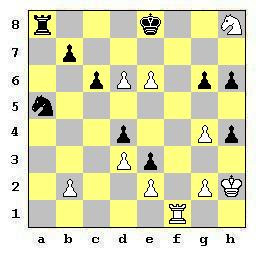In 1955 he won the Youth Championship in Yugoslavia, and in a match of six games he proved to be equally strong with young Bent Larsen from Denmark. In 1958 he became International Master in over the board Chess. In 1960, with the Yugoslavian team, he took part in the Chess Olympiad of Leipzig, and he was named second-best player in the Student Chess Olympiad of Leningrad. In 1963, after finishing his studies in Belgrade University, he moved to Ohio USA and he settled there.
Vukcevich preferred the academic career from the chess career, and just as he arrived in the U.S.A. he entered the doctorate program in metallurgy at the Massachusetts Institute of Technology (MIT). After that he was teaching in Case Western Reserve University of Cleveland Ohio for six years, and then he was a member of the staff in General Electric, reaching in 1989 the position of the Chief scientist. He was a nominee for Nobel Prize in Chemistry. He was the author of two scientific books.
Vukcevich was very active with league chess. In 1969 he tied at first place of the Open Chess Tourney of USA together with GM Pal Benko. In 1975 he was third in the Closed Championship of USA, surpassing Samuel Reshevsky, Robert Byrne, Pal Benko and Arthur Bisguier, among others. In the period 1976 thru 1979 he was playing in chess teams of telephone companies, achieving score 16.5 points in 22 games, where he managed to win Yasser Seirawan, Nick De Firmian, Leonid Shamkovich and Arthur Bisguier.
Vukcevich became widely known as composer of chess problems, not as chess player, since he was the first American citizen to be honored with the title of International Grandmaster in Composition by the International Chess Confederation (FIDE). In 1981 he has published “Chess by Milan : Problems and games by Dr. Milan Vuksevich” and in 1998 he was included in Chess Pantheon of USA, being the second person there after Sam Loyd, for great achievements in chess composition. He has repeatedly said with gratitude that he owed everything to his tutor, Triantafyllos Siaperas.
After his death, the Vukcevich Super Cup was created to honor his name.
Vukcevich's compositions are collected in the book “My Chess Compositions”, 2003. He created problems of all kinds, Orthodox, Selfmates, Helpmates, Fairy (with fairy pieces or retroanalysis) and Studies.
We have already presented a helpmate duplex problem by Vukcevich. Here we will see one of his retro problems.
 | (Problem 157) M. Vukcevich, "Problem", 1966 White retracts a move and then mates in 3 moves. (Retroanalysis). W(-1) #3 retro (10+10) |
| [r3k2S/1p6/2pPP1pp/s7/3p2Pp/3Pp3/1P2P1PK/5R2] | |
White can take back any last move and then white might try to play {1.Sxg6? [2.Rf8#]}, but black can defend himself with {1... 0-0-0!}. In this problem we must discover the unique move that white will retract, which will also prove that black has lost the right for castling. The solution is as follows :
The white retracts the move 1.e5xd6 e.p., that is Black has supposedly played d7-d5 before and this pawn was captured en-passant.
The new position, with white pawn on e5 and black pawn on d7, means that black has no right for castling! The continuation is...
1.Sxg6! [2.Rf8#] d5
2.exd6 e.p. ~
3.Rf8#
Why has black lost the right for castling? Let us study the new position, with the skeleton of pawns without pieces, in diagram-158.
 | (Diagram 158) Auxiliary diagram with skeleton of pawns, after white has retracted one move in Problem-157 by M. Vukcevich, (8+9) |
| [2b5/1p1p4/2p1P1pp/4P3/3p2Pp/3Pp3/1P2P1P1/5B2] | |
As we see in diagram-158, the white-squared Bishops bBc8 and wBf1 were captured on their initial position without having ever made a move. The black Pawn bPf7 captured two white pieces and went to column-h, and the black Pawn bPa7 captured three white pieces and went to square d4. So, five white pieces were captured while there are missing only four, the white Queen wQ, a white Rook wR, the black-squared white Bishop wBc1, and a white Knight wS. The fifth captured white piece came from promotion of wPa2, the only white Pawn that is missing, which had reached a7 and then
(1) either wPa7 was promoted to a8, thus the black Rook bRa8 has moved and black has lost the right for castling,
(2) or wPa7 was promoted capturing a black piece on b8.
But the skeleton of the white Pawns proves that this second hypothesis is false. The white Pawn wPh2 captured a black piece and went to file-g. The white Pawn wPf2 captured a black piece and went to file-e (on e6). The white Pawn wPc2 captured two black pieces and went to file-e (on e5). So, four black pieces were captured and exactly four black pieces are missing, the black Queen bQ, a black Rook bR, the black-squared black Bishop bBf8, and a black Knight bS. No black piece remains to be captured from wPa7 on square b8, and no black piece came from promotion since no black Pawn is missing.
Conclusion : bRa8 has moved and black cannot defend with castling.
(This post in Greek language).
No comments:
Post a Comment